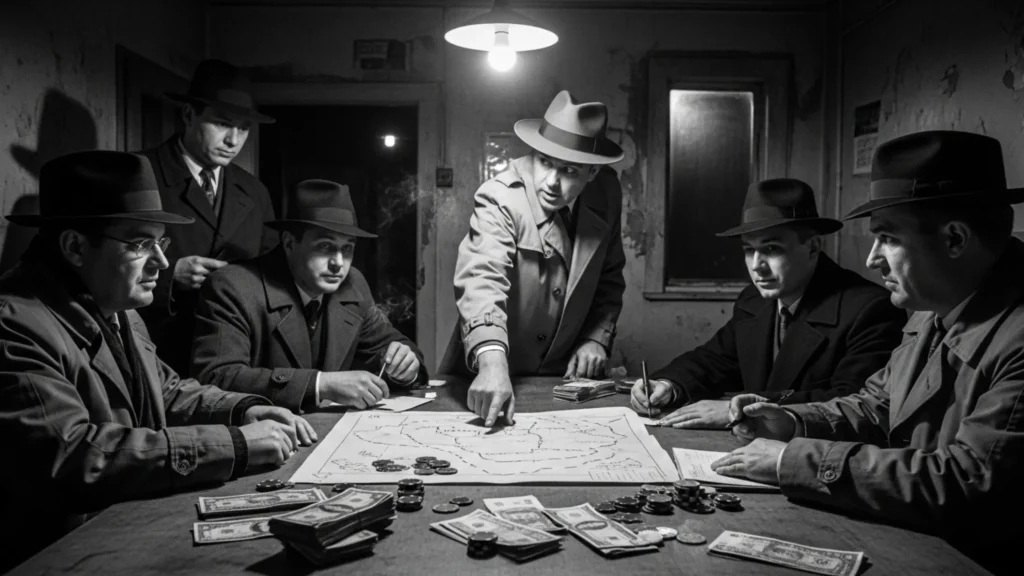Cómo la economía del mercado negro moldeó la inversión moderna

Black Market Economics Shaped Modern Investing in ways that are often uncomfortable to admit, yet undeniable when examining historical data.
Anuncios
The pursuit of high returns under conditions of extreme scarcity and unregulated risk laid the groundwork for many of today’s sophisticated financial instruments.
This hidden lineage connects the illicit trading dens of the past directly to the modern, regulated exchange floors.
The black market, by its very nature, operates under perfect information asymmetry, extreme leverage, and high volatility.
These are the same variables that drive returns and risks in Wall Street’s most complex derivatives and quantitative trading strategies today.
Anuncios
The underworld was, paradoxically, an early laboratory for pure, unrestricted market behavior.
Why Did the Black Market Become a Laboratory for Risk Management?
The fundamental characteristic of any black market is risk: the risk of arrest, violence, and seizure.
Because the legal system offers no protection, participants had to develop complex, informal systems of trust and rapid payment, creating highly efficient, though dangerous, transactional environments.
These environments demanded instantaneous, accurate pricing based on rumor and scarcity.
This need for quick risk assessment under extreme duress forced the creation of rudimentary hedging strategies, where individuals sought to lock in profits quickly to offset potential total losses.
++ La curiosa conexión entre los piratas y el derecho corporativo moderno
What is the Historical Link Between Smuggling and Forward Contracts?
The necessity of securing goods that might be seized by authorities created the first forms of “forward contracts.”
A smuggler needed assurance that a future shipment would be honored, even if the goods were destroyed or delayed en route.
A buyer would pay a premium upfront a deposit to lock in the price of a future, uncertain delivery.
This is the conceptual ancestor of today’s formal forward contract, used globally to hedge against commodity price volatility.
Lea también: La isla que usaba piedras de cuatro toneladas como moneda
How Did Trust Replace Legal Contracts in Early Trading?
In unregulated markets, trust is the only collateral. Reputations became highly valuable assets.
Anyone who reneged on a deal was immediately excluded, a form of reputational capital that enforced contracts without recourse to courts.
This immediate, brutal market mechanism for punishing bad actors ensured high transactional efficiency.
The reliance on reputation and immediate exclusion prefigured modern over-the-counter (OTC) markets, where reputation and handshake deals still matter immensely among institutional players.

How Did Scarcity and Prohibition Drive Price Discovery?
Prohibition eras, particularly the American Prohibition of the 1920s, created highly artificial scarcity.
This environment became a textbook case study in price discovery under inelastic supply and high, constant demand. Black Market Economics Shaped Modern Investing through this dynamic.
The volatility in black market goods, such as smuggled alcohol, far surpassed that of any regulated commodity.
These markets offered a perfect view of how consumer desire, regulatory risk, and supply chain fragility influence price action.
Leer más: Lo que el Titanic puede enseñarte sobre el riesgo empresarial
What Was the Origin of Leverage in Illicit Markets?
Leverage the use of borrowed funds to amplify returns was rampant in smuggling operations.
Operators frequently borrowed heavily against future, uncertain shipments to finance the operation. If the shipment arrived, returns were massive. If it was seized, the loss was total.
This practice showed early investors the power of high leverage, where small changes in the asset price (the contraband) could lead to exponential gains or catastrophic losses.
This extreme risk profile became the blueprint for modern margin trading.
Why is the Dutch Tulip Mania the Ultimate Analog?
The infamous Dutch Tulip Mania of the 17th century serves as the ultimate historical analogy for this phenomenon.
Though technically not a black market, the mania centered on unregulated trading of tulip futures contracts, not the physical bulbs.
This episode demonstrated the power of herd behavior, speculation, and the trading of pure promise, rather than underlying value.
The crash that followed remains a cautionary tale about market bubbles and speculation, lessons that Black Market Economics Shaped Modern Investing by illustrating peak irrationality.
Which Modern Concepts Can Be Traced Back to Illicit Trading?
Several advanced financial mechanisms, seemingly born on Wall Street trading desks, have structural parallels to illicit markets.
These concepts evolved from necessary expedients used by criminal enterprises to manage funds and mitigate seizure risk.
The core ingenuity of illicit markets lies in finding complex, non-traceable transactional pathways. This same creative drive for opacity and efficiency fuels financial engineering today.
How Did Money Laundering Influence Complex Transaction Structuring?
Money laundering requires the creation of complex, multi-layered transactions to obscure the source of funds.
This led to the creation of intricate shell companies and cross-border invoicing structures long before they became commonplace for legal tax optimization.
These complex structures were an early form of financial engineering, specifically designed to create an opaque audit trail.
The techniques used to “layer” dirty money inspired some legal structures used today to move capital across borders efficiently.
What is the Parallel Between Digital Currencies and the Silk Road?
The development and popularization of cryptocurrencies were significantly accelerated by black markets, particularly the notorious Silk Road marketplace.
Bitcoin was the perfect transactional tool: borderless, pseudonymous, and difficult to seize.
The need for a secure, unregulated payment system within the dark web provided cryptocurrencies with their initial widespread testing and adoption phase.
This demand proved the real-world utility of blockchain technology, fundamentally altering the trajectory of modern finance.
Why is Data on Illicit Markets Crucial for Regulatory Bodies?
Paradoxically, data extracted from monitoring illicit markets provides crucial insights for regulators attempting to maintain market stability and fairness in legal markets.
Understanding how bad actors exploit vulnerabilities is key to preemptive regulation.
This constant cat-and-mouse game between regulators and the underworld drives innovation in surveillance and compliance technology.
Black Market Economics Shaped Modern Investing by forcing regulatory bodies to become constantly adaptive.
What Does the Shadow Economy Reveal About Liquidity and Pricing?
The shadow economy is massive and offers real-time data on global demand for restricted goods (e.g., narcotics, weapons, intellectual property). This data reveals true, non-taxed, non-regulated pricing points.
The Dark Web Virus Market. Prices for zero-day exploits and sophisticated malware fluctuate wildly based on scarcity and effectiveness.
This volatility mirrors the pricing models used for high-risk, unlisted assets and complex proprietary trading algorithms.
Antiquities Smuggling. The price of a specific stolen artifact is determined by its scarcity and the immediate willingness of a few wealthy, motivated buyers to pay a premium.
This reflects the dynamics of a specialized, illiquid asset class in a legal market.
What is the Statistical Scale of the Shadow Economy?
The sheer size of the shadow economy makes it impossible to ignore.
A 2018 study by the IMF estimated that the average size of the shadow economy in 158 countries was approximately 31.9% of GDP. This massive financial activity, while illegal, demonstrates economic forces operating at scale.
This massive scale means techniques proven efficient in the black market whether for logistics, pricing, or risk transfer inevitably trickle into the legal financial mainstream, where they are sanitized and formalized.
Key Financial Concepts Traced to Underworld Principles
| Underworld Principle | Illicit Context | Modern Financial Concept |
| Reputational Collateral | Smuggling, Drug Trade | Over-the-Counter (OTC) Markets, Private Equity Deals |
| Future Pricing | Prohibition-era Liquor Shipments | Forward Contracts, Futures Hedging |
| Asset Obscuration | Money Laundering | Complex Offshore Trust Structuring, Layering |
| Non-Traceable Payment | Dark Web Marketplaces (Silk Road) | Cryptocurrencies, Decentralized Finance (DeFi) |
Conclusion: The Uncomfortable Mirror of Finance
The influence of Black Market Economics Shaped Modern Investing is a testament to the persistent ingenuity of human desire and the efficient ruthlessness of unregulated markets.
The tools of hedging, leverage, and opaque structuring did not originate in sterile boardrooms; they were refined under pressure.
From the necessity of the forward contract in smuggling to the utility of pseudonymous currency on the dark web, the shadow economy has served as a crucible for financial innovation.
Modern regulation seeks to control and mitigate these forces, but it cannot deny their impact on our financial systems.
This uncomfortable truth should compel investors to understand the fundamental dynamics of risk and reward, regardless of their legality.
Does the existence of a massive, non-regulated shadow economy still skew the valuation of legal assets today? Share your economic insights in the comments.
Preguntas frecuentes
Does “Black Market Economics” include just organized crime?
No. Black Market Economics includes any exchange of goods or services operating outside government regulation and taxation.
This ranges from large-scale organized crime (narcotics, arms) to smaller, localized informal economies (unlicensed street vendors, cash labor).
How is the “dark web” relevant to modern financial modeling?
The dark web, particularly its marketplaces, provides clean data on supply and demand for high-value digital assets (like data and malware).
This extreme, unregulated pricing behavior is used by quantitative analysts to model liquidity and risk in high-volatility, non-traditional assets.
What is the fundamental difference between black market risk and legal market risk?
In the legal market, risk is primarily financiero (losing capital). In the black market, risk is both financiero y physical/legal (imprisonment, violence, asset seizure).
The dual nature of black market risk necessitates faster, more extreme hedging.
Is the use of shell companies for legal tax avoidance influenced by illicit practices?
The structural concepts, particularly the layering of ownership to achieve opacity, were refined by money laundering operations.
While shell companies have many legitimate uses, the complex structures used for aggressive, legal tax minimization share conceptual DNA with methods developed to disguise illegal funds.
Why do regulators study black market mechanisms?
Regulators study these mechanisms to anticipate how bad actors will exploit future technologies or regulatory gaps.
By understanding the criminal blueprint, regulators can proactively design anti-money laundering (AML) and anti-fraud measures that address real-world vulnerabilities, keeping the legal market more secure.
